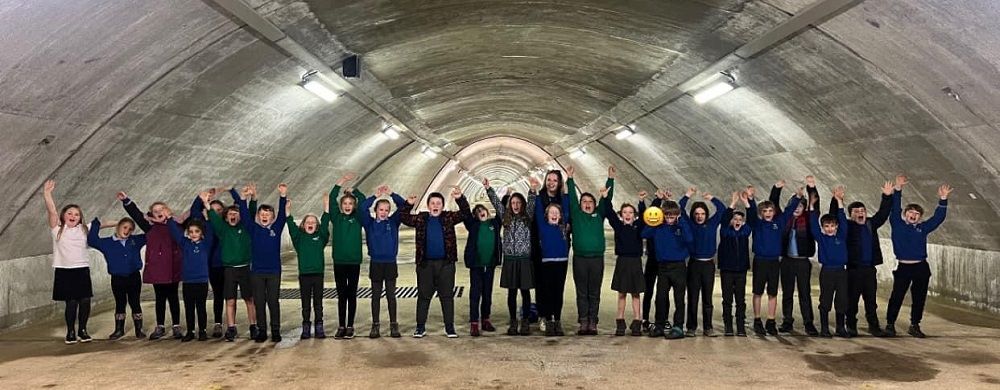Case Study: Employer Engagement Projects at Acomb First School
At Acomb First School in Hexham, Northumberland, embedding career guidance into the curriculum isn’t just about meeting benchmarks—it’s about bringing learning to life for their students. Through a carefully planned Employer Engagement Project, led by headteacher Hannah Williamson and teachers Robyn Derby and Laura Waugh, the school developed a hands-on, engaging approach to connect classroom learning with real-world careers. The initiative involved 49 students from Key Stages 1 and 2, working closely with local businesses to foster awareness of career pathways and opportunities in their community.
The projects aligns with several Benchmarks, including encounters with employers (Benchmark 5), workplace experiences (Benchmark 6), and linking curriculum learning to careers (Benchmark 4).

Challenges
The team at Acomb First School wanted to address a fundamental gap: helping young students understand the relevance of their learning and how it connects to real-world careers, particularly in their local area. This involved several challenges:
- Raising awareness of local job opportunities across diverse industries.
- Making career-related learning accessible and meaningful for primary-aged pupils.
- Finding ways to engage employers and age-appropriate activities.
- Planning an ambitious and multifaceted project while working around the school’s and employers’ schedules.
Approach and Solutions
The school began with professional development for all staff to explore local labour market information and strategies to embed careers in the curriculum. This training informed the planning of the Employer Engagement Projects, which were embedded into the curriculum.
Key Steps in the Process:
1. Collaborative Planning:
Staff developed project plans that integrated curriculum links (e.g., science, geography, and design technology) with specific career-related learning objectives. These plans were structured week-by-week to include “hooks,” key learning outcomes, and potential employer interactions.
2. Local Employer Engagement:
The team reached out to local businesses that aligned with the project themes. Phone calls were identified as the most effective method for initial contact, allowing for detailed discussions about the objectives and benefits of the collaboration. Teachers then took over communication to finalise details and create a shared vision with employers.
3. Integration of Acomb Skills Framework:
The school’s bespoke “Acomb Skills” framework, based on the Skills Builder Universal Framework, was used to help students identify and reflect on the skills they were developing throughout the projects.
4. Hands-On Learning Experiences:
Two class projects were created, each with tailored employer engagements, field visits, and hands-on activities:
- Chestnut Class (Renewable Energy): Linked to science and geography, students visited Kielder Water and Forest Park to learn about hydropower and its environmental impact. They worked with Northumberland College on a wind turbine workshop and visited Cragside National Trust, the first UK home powered by hydroelectricity. This project deepened their understanding of green energy and the associated careers.
- Maple Class (Food Production): With a focus on science, design technology, and geography, students explored food production from farm to table. Visits included Wheelbirks Farm for an inside look at British farming and ice cream production, Hextol Tans Café to learn about careers for people with disabilities, and Hjem, a Michelin-starred restaurant, to experience the hospitality industry. Activities ranged from mocktail making and foraging to cooking canapés for a showcase event.
5. Showcase Events:
Each class held a showcase to share their learning with parents, staff, and business partners. Chestnut Class presented a rap about renewable energy, while Maple Class served canapés they had prepared and demonstrated their hospitality skills.
Impact
Student Outcomes:
The projects had a significant impact on students, increasing their awareness of local career opportunities and deepening their understanding of how classroom learning connects to the real world.
- Students developed confidence in communication and teamwork, showcased through their professional presentations at the showcases.
- They gained practical knowledge about industries such as renewable energy, agriculture, and hospitality, as well as insights into different career pathways.
- The integration of Acomb Skills allowed students to identify transferable skills such problem-solving, and creativity.
Student Feedback:
- Sam (Maple Class): “I loved serving the food to the parents at the showcase. Working with Hextol and Hjem helped us to learn how to cook.”
- Marnie (Chestnut Class): “It was a very interesting project and we learnt a lot about energy and how important it is for the planet. My favourite part was performing the rap.”
Staff and Employer Feedback:
Staff noted that the hands-on experiences and direct interactions with professionals made the learning more authentic and memorable for students.
Employers were impressed with the students’ enthusiasm, knowledge, and professionalism.
- Northumbrian Water staff: “I was blown away by how great the entire class was. The rap… loved it. Laura should be very proud of the delivery. I hope Kielder can be involved in more projects in the future.”
- Connor from Northumberland College: “The kids were brilliant—really confident and well spoken. They are a credit to the school.”
Community Impact:
Parents expressed overwhelming positivity about the initiative, praising the children’s confidence, knowledge, and the opportunities the projects provided.
Sustainability and Lessons Learned
Tips for Replication:
- Plan in Advance: Early planning is crucial to allow time for employer engagement and aligning schedules
- Clear Communication: Building strong partnerships requires sharing a clear vision and objectives with employers.
- Flexibility: Adjust project timelines to fit employers’ availability to ensure their participation.
- Start Small: Begin with one point of contact to establish trust and develop a sustainable working relationship.
Future Plans:
The school intends to expand the projects in the future, running them across different terms to manage workloads more effectively. Planning for the next academic year will begin in September to ensure ample time for preparation.
